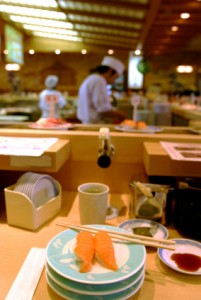In Part I, I covered three of the six important components of a PowerPoint presentation in terms of a sushi restaurant analogy. In this blog, I will discuss the three remaining areas: the server, atmosphere, and customers.
Server (Presenter)
Most of the time you’re the chef and the server. You’re responsible for both building and delivering a PowerPoint presentation. Think about the last waiter or waitress that received a great tip from you. He or she probably possessed one or more of the following traits: personable, a good communicator, attentive to your needs, knowledgeable about the menu, and efficient. The same qualities are important for presenters, and having a stellar presentation doesn’t guarantee success. A lousy server can ruin or dampen a great meal. A common phrase associated with restaurant success is “location, location, location.” Similarly, another phrase which is frequently associated with presentation success is “practice, practice, practice.” You may not be the best presenter in the world, but ample practice can significantly enhance the presentation experience for you and your audience.
Atmosphere (Presentation Environment)
Besides the food and the service, sushi restaurateurs also need to worry about the atmosphere. I know I feel cheated if I eat at a sushi restaurant that doesn’t make me feel as though I have stepped into a little piece of Japan. As a presenter, you need to be aware of your presentation environment and ensure everything is in place to ensure your presentation is a success. Failing to anticipate problems with aspects such as the visual display, sound, lighting, seating configuration, and other environmental considerations can lay waste to hours of work invested in preparing your slides. Depending on your presentation’s purpose and audience, the atmosphere may require more or less attention. However, even at fast food restaurants, people expect the tables and floors need to be clean. For informal presentations, you still want to be sure that people can see your slides and are not distracted by anything that could prevent them from focusing on your message.
Customers (Audience)
A sushi restaurant cannot afford to be out of touch with its customers, or it will join the ranks of thousands of restaurants that fail each year. As a presenter, your “customers” are your audience. Lots of presentations fail each year because presenters forget to pay proper attention to the characteristics, abilities, needs, and moods of their audiences. Before you begin preparing or presenting a single PowerPoint slide, you will want to clearly understand who your audience is, what their level of understanding is on your topic, and what expectations they have for your presentation. During your presentation, you will want to pay attention to the audience’s mood and adjust your approach accordingly. You may need to speed up or slow down, spend more time on a particular subject or skip entire slides, or do something to wake them up or keep them focused. At the end of your PowerPoint presentation, your audience will gauge whether your slides were informative and memorable. Hopefully, they enjoyed generous portions of tasty “slide sushi” and recommend your presentation to their friends and colleagues.


